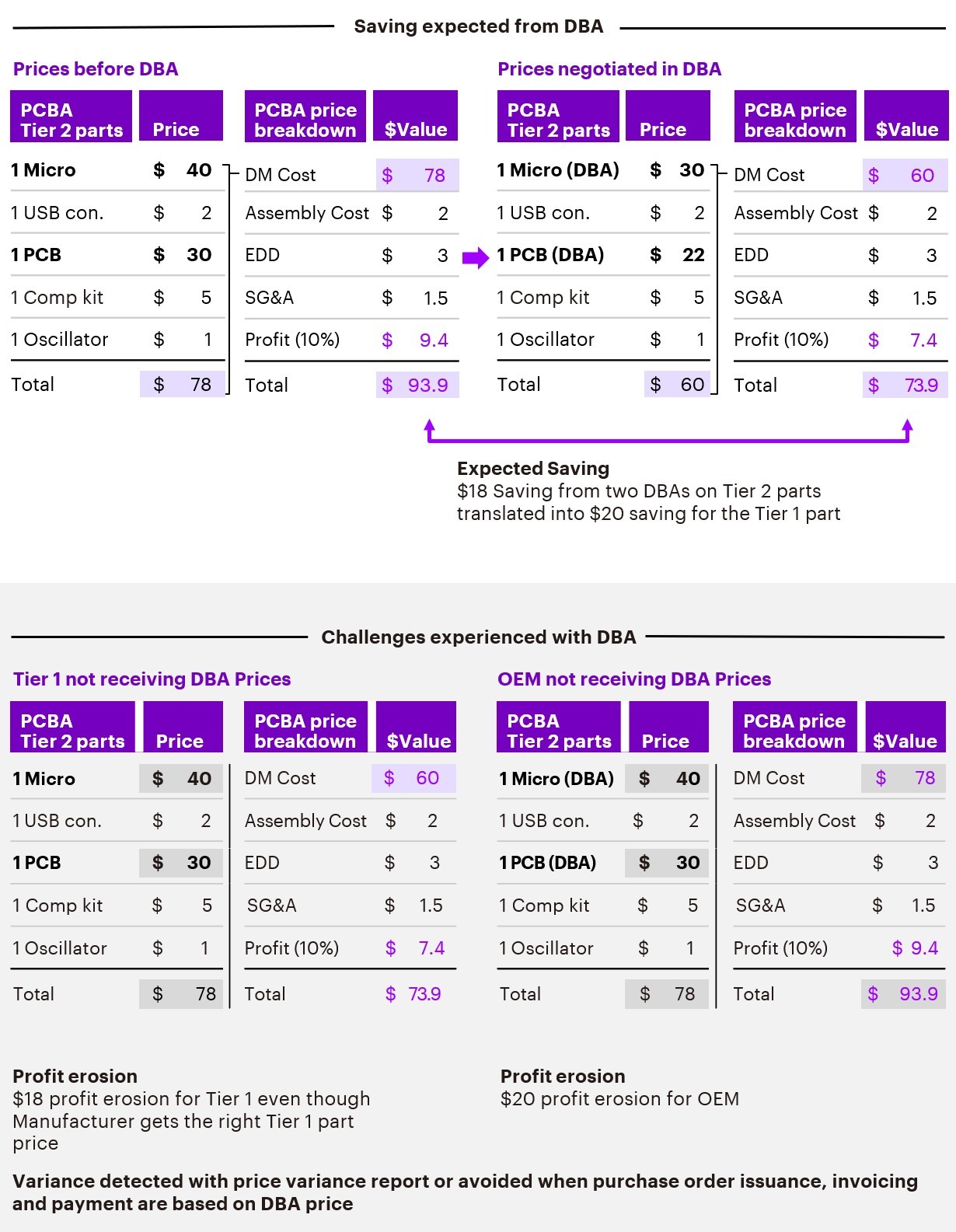Editor’s Note: Olusegun Ladipo, Adam Robbins, and Andrew Marquardt work for Accenture.
Blockchain technology—the underpinning of cryptocurrencies—is becoming more prevalent in a growing variety of applications. When it comes to the supply chain, most people immediately think about how Blockchain can help drive part traceability. But there’s another interesting application for Blockchain that’s not getting much attention: providing price transparency across a manufacturer and its suppliers, which could create tremendous value.
This is especially true when Blockchain is used to help manufacturers enforce Directed Buy Agreement (DBA) price compliance, which could equate 3%+ of DBA spend and hundreds of millions of dollars in savings for a typical large manufacturer.
DBAs and the Visibility Challenge
A DBA is an agreement in which a manufacturer requires a direct (i.e., Tier 1) supplier to purchase from a specific sub-supplier, at a competitively negotiated price, certain raw materials, parts, or components that go into a finished product. DBAs help reduce upfront costs for sub-component parts and create greater opportunities to leverage purchasing volumes, which are typically passed from the Tier 2 supplier’s material price into the Tier 1 supplier’s price.
However, to be effective, DBAs need data visibility to enforce contract prices with suppliers. In an ideal world, a buyer can construct a complete “supply tree” (Figure 1) that provides price and part data visibility across every part’s supplier ecosystem, and DBAs to identify the non-price-compliant DBA suppliers in real time. This kind of visibility requires an unprecedented amount of collaboration and trust between a manufacturer and its suppliers—which, in turn, needs a system that allows data to be securely stored and shared, manages peer-to-peer privacy, and eliminates the need for time-consuming, inefficient manual reconciliation of price variance discrepancies.

Figure 1: A complete supply tree for part and price visibility
Blockchain to the Rescue
This is where Blockchain comes into play. A Blockchain-based multi-party system (MPS) can not only automate the processes related to contract price enforcement, but also identify volume discounts and potential supply risks across the value chain in a case where multiple Tier x suppliers are shared with varying Tier x-1 suppliers. It also can eliminate a lot of non-value adding, manual work related to contract price enforcement, enabling category managers to shift their efforts to more strategic initiatives like defining category strategies and fostering long-term supplier relationships.
A Blockchain-based MPS can help manufacturers more effectively execute DBAs and capture lost value in two key ways:
1.) Providing Real-Time Value Chain Transparency
First, a Blockchain-based MPS can span the entire supply tree structure and securely stores contracts and DBA terms (Figure 2). To provide a complete supply tree visibility, each organization’s sales, procurement transactions, and contracting data are fed into the Blockchain through API calls to the Blockchain, which stores contract and DBA pricing terms as a reference point. The Blockchain then establishes DBA price baselines among all contracting parties to detect DBA price inconsistencies.

Figure 2: The Blockchain-enabled DBA data flow
2.)Automating Reporting and Price Compliance
Second, it supports DBA price compliance enforcement by enabling automated reporting and price compliance alerts. Once the data pipelines for all three parties in Figure 2 feed into the Blockchain, DBA price variance reports and alerts can set up to be automatically triggered to support the manufacturer’s price compliance enforcement process. Reporting capabilities include price variance notification, volume discount opportunities , and supply risk identification to support any necessary mitigation and diversification.
Figure 3 illustrates how a Blockchain solution could help a manufacturer——and its tier suppliers enforce DBA price compliance. In this example, which involves a simplified version of Printed Circuit Board Assembly (PCBA) BOM, Blockchain can help a manufacturer avoid significant profit erosion on each PCBA purchased by automatically detecting and reporting price variances across the Tier 1 supplier and the two Tier 2 suppliers involved in DBAs—or even eliminate these variances altogether when purchase order issuance, invoicing, and payment are all based on the DBA price recorded in the system.

Figure 3: An example of how a Blockchain can help enforce DBA price compliance for a manufacturing company
In a world of growing supply chain complexity, material availability and pricing pressures, DBAs can help manufacturers exert much greater control over their Bill of Materials (BOM) and optimize their cost of raw materials and parts—and a Blockchain solution can play a critical role in this regard. It can virtually eliminate confidentiality concerns, automate and standardize manual and inconsistent activities within organizations, and dramatically boost administration efficiency—while ensuring compliance with DBAs’ pricing terms. Used in this way, a Blockchain solution can help manufacturers recover hundreds of millions of dollars in value, for a direct and significant impact on the bottom line.
The potential does not stop there, Blockchain can also support use cases such as: SKU or software license traceability; conflict minerals tracking; supplier quality register; delivery confirmation; and supplier ESG reporting. The applications are almost boundless for supply chain activities.
SC
MR


More Finance
- Services sector sees growth in October, reports ISM
- Looking back at NextGen 2024
- Manufacturing again contracts in October, reports ISM
- NextGen Supply Chain Conference set for October 21-23
- Estée Lauder, Schneider Electric and S&S Activewear to receive NextGen End User awards
- 2024 Robotics Application Conference announces session, speaker lineup
- More Finance
Latest Podcast

 Explore
Explore
Business Management News
- Strengthening customer fulfillment: Building a strategic stakeholder network
- The hard job of teaching soft skills
- Trump picks former Wisconsin congressman Sean Duffy for DOT secretary
- Made in Mexico, manufactured by China
- Retail sales see gains in October, reports Commerce and NRF
- Balancing green and speed: Home delivery insights from the pandemic era
- More Business Management
Latest Business Management Resources

Subscribe

Supply Chain Management Review delivers the best industry content.

Editors’ Picks




